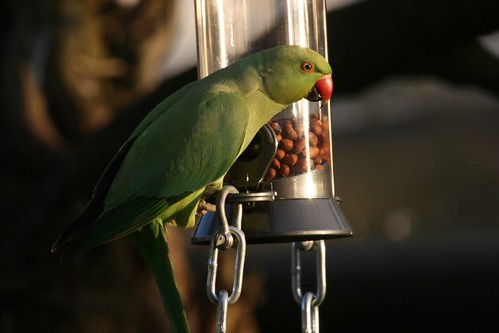 Urban Ring-necked parakeet fouragin on a back-yard peanut feeder (Leiden, the Netherlands)Britain’s naturalised parrot is now officially a pest. Forty years after it first bred on the outskirts of London, the ring-necked parakeet today joined gulls, crows and magpies on the short list of birds which can be legally shot without special permission.
Urban Ring-necked parakeet fouragin on a back-yard peanut feeder (Leiden, the Netherlands)Britain’s naturalised parrot is now officially a pest. Forty years after it first bred on the outskirts of London, the ring-necked parakeet today joined gulls, crows and magpies on the short list of birds which can be legally shot without special permission.
The tropical parakeet, whose native range stretches from Africa to the Himalayas, has become an increasingly familiar sight in south London and Surrey in recent years and its numbers are mushrooming, with one roost in a Surrey sports ground sometimes holding several thousand birds.
Many people are charmed by its brilliant, iridescent-green plumage and exotic screech. But growing fears that it may damage native wildlife and crops – in the tropics it is widely considered a pest – today led Natural England, the Government’s wildlife watchdog, to add the bird to the “general licence” of species which can be controlled (that is, culled) without individual permission, if damage is being done.
Three other non-native birds joined it on the list today – the monk parakeet from South America, of which a few species breed in the northern home counties, the Canada goose and the Egyptian goose. All are considered to pose a threat in one way or another either to native wildlife, public health or public safety.
Their addition to the list does not mean it is open season on the birds, with a shooting free-for-all in prospect. But it does mean that if a landowner or any other “authorised person” has good reason to believe the birds are causing a specific problem, he is free to shoot them without seeking an individual licence to do so, as would have been necessary in the past.
The world’s most widespread wild parrot species, the ring-necked parakeet was first recorded successfully breeding in the wild in England in 1969. A population is believed to have been established with birds that escaped from aviaries and others released by sailors returning from the tropics. The British breeding population is now estimated to be 4,700 pairs and it is expanding steadily; the bird has reached as far north as the Scottish border.
Concerns about it have long been voiced. Aggressive, and a hole-nester, it is thought it might drive out British hole-nesting species such as woodpeckers. It also causes major crop damage, especially to fruit trees, on its native range. Tony Juniper, the former director of Friends of the Earth who is one of the world’s leading authorities on parrots, once said it had the potential to be “the grey squirrel of the skies.”
Natural England said today the parakeet and the other three birds had been added to the “general licence” as a precautionary part of its non-native species strategy. “This is not about telling people to go out and kill them but it is about facilitating people to control them if they've got a good reason to do so,” a spokesman said. “This is acknowledging that these are birds which can cause problems.”
The Royal Society for the Protection of Birds today displayed what might be described as an uncomfortable acceptance of the move. “We can see why Natural England have put these species on the general licence, for good conservation reasons,” said Dr Mark Avery, the RSPB’s conservation director. “Non-native species cause problems for native wildlife across the globe, sometimes leading to species extinctions. At the moment these species aren’t causing conservation problems in the UK, but they might in future. However, you still need a legitimate reason under the general licence to kill them."